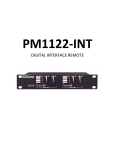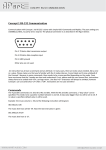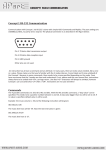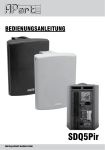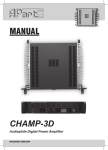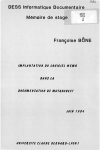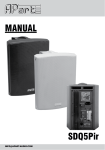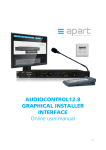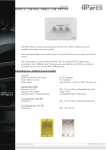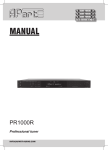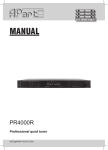Download APart PM1122-INT
Transcript
PM1122-INT DIGITAL INTERFACE REMOTE PM1122‐INT DIGITAL INTERFACE REMOTE WWW.APART-AUDIO.COM / [email protected] PM1122-INT DIGITAL INTERFACE REMOTE Table of Contents PM1122‐INT .................................................................................................................................... 1 Table of Contents ............................................................................................................................ 2 Overview ......................................................................................................................................... 3 PM1122‐INT front panel description ..................................................................................... 3 PM1122‐INT back panel description ...................................................................................... 4 RS232 Cable Specifications ............................................................................................................. 4 Instruction set PM1122‐INT ............................................................................................................ 5 Commands ............................................................................................................................. 5 Attributes ............................................................................................................................... 5 Controls .............................................................................................................................. 5 Settings ............................................................................................................................... 6 Overview table ................................................................................................................... 8 Bi‐directional communication ............................................................................................... 8 Easywave ......................................................................................................................................... 9 Presets ........................................................................................................................................... 11 PM1122 Control Panel Software .................................................................................................. 13 Controlling the PM1122‐INT with Hercules .................................................................................. 19 Help, where is my COM port? ....................................................................................................... 24 How to deal with bi‐directional communication .......................................................................... 24 2 WWW.APART-AUDIO.COM / [email protected] PM1122-INT DIGITAL INTERFACE REMOTE Overview The PM1122 Pre‐amp can be remote controlled by the PM1122‐INT. The PM1122‐INT can be controlled in 3 different ways: • Using RS‐232 • Using the contacts to recall presets • Using the optional RF module For control using the RS‐232 port, the PM1122‐INT accepts strings of ASCII characters to control and read settings of music level, microphone mix level and the input selector of both zones. Further, the RS‐232 port will have to be used to store presets, adjust minimum and maximum level settings. Strings can be sent via third‐party software like Hilgraeve’s Hyperterminal or the freeware utility “Hercules SETUP utility” from HW‐group. For preset control using contacts, it’s needed to store the presets using RS‐232. It can be done using terminal software (Hyperterminal, Hercules, ...) or with the APart PM1122 Control Panel software. Please note the APart software runs only on Windows® platforms, it’s freely downloadable but no support or guaranties are given. Once the presets are stored, no RS‐232 communication is needed anymore. Refer to the chapter Presets for more information. For control using the optional RF module, no configuration with RS‐232 is needed. Once the module is mounted (see chapter “Easywave” on page 9), the push buttons at the front side are enough to assign a switch to a zone. Please note there are some features which can be configured using RS‐232 but for normal operation, it’s not needed! PM1122INT front panel description 6 7 8 9 10 11 19200 9600 4800 2400 1 2 3 4 5 1. 2. 3. 4. 5. 6. 7. 8. 9. 10. 11. Clear wireless remotes knob Wireless remote learn button for zone 1 Learn led for zone 1 Wireless remote learn button for zone 2 Learn led for zone 2 Music selector indicator for zone 1 Music level indicator for zone 1. Microphone mix level indicator for zone 1 Music selector indicator for zone 2 Music level indicator for zone 2 Microphone mix level indicator for zone 2 At power up, LED bar 11 will show the current baud rate. See above for the possible values. Note: buttons 1, 2 and 4 have been mounted slightly recessed to avoid unintended operation. If necessary, use a pen or pencil to push these buttons. 3 WWW.APART-AUDIO.COM / [email protected] PM1122-INT DIGITAL INTERFACE REMOTE PM1122INT back panel description 1 2 3 4 5 1. 2. 3. 4. 5. RF antenna (optional) Euroblock Connector for Preset recall by contact DB‐9 RS‐232 connector RJ45 Zone 1 CAT5 cable connector RJ45 Zone 2 CAT5 cable connector Note: The RJ45 connectors are not LAN connectors, so please never attempt to connect it to a computer or network or anything other than a PM1122‐INT! The PM1122‐INT will only operate if at least one zone is connected to a PM1122 pre‐amplifier using a standard CAT5 cable. Note that the selector button on the PM1122 must be set at “REMOTE”. Power supply for the interface is provided by the pre‐amplifier. Do not attempt to connect the PM1122‐INT CAT5 connectors to anything other than the PM1122. RS232 Cable Specifications RS232 connection on the PM1122 interface: A straight through PC Serial Cable is used to communicate from the RS232 port to a third‐party controller such as a PC. If your PC doesn’t have a serial port, a USB to RS‐232 adaptor has to be used. Such cables and/or adaptors can be sourced locally. Every computer shop should be able to supply it. Pin 2: TX data: data transmission output Pin 3: RX data: data reception input Pin 5: GND: ground Other pins are not used. 4 WWW.APART-AUDIO.COM / [email protected] PM1122-INT DIGITAL INTERFACE REMOTE Instruction set PM1122INT The PM1122‐INT can be controlled using RS‐232. During power up, the current baudrate is shown on a LED bar. Please refer to “PM1122‐INT front panel description” at page 3 for the corresponding values. Initial port settings are 19200 bits per second, 8 data bits, no parity, 1 stop bit and no flow control. Only the baud rate can be configured at different values. Standard ASCII strings are used to control the PM1122‐INT so it’s possible to use Terminal software (e.g. HyperTerminal, Hercules, ...) to test, configure and/or control it. Instructions are not case sensitive. Each string must be ended with a Carriage Return (<CR>, ASCII code 13 or ”\n”) The string is structured in the following order: Command Attribute Parameter1 Value<CR> Strings require a space between each parameter; the last character in the string needs to be a carriage return <CR>. Line feed <LF> characters are ignored so they may be used. An instruction consists of a command, an attribute and possible one ore more parameters. E.g. the instruction to switch the music volume from zone 1 at maximum will look like this: SET MSCLVL ZONE1 100<CR> where SET is the instruction, MSCLVL the attribute, ZONE1 the first parameter and 100 the second parameter which is the value. Commands This is a list of commands with a brief description SET Set the value of a variable GET Get the value of a variable RCL Recall a Preset LRN Learn a code of Easywave RF switch CLR Clear preset or Easywave RF identification codes HELP Lists Commands and Attributes LST Lists Commands and Attributes (same as HELP) STR Store a Preset INC Increase the value of a variable DEC Decrease the value of a variable Attributes The attributes can be grouped in controls and settings. Controls will really “control” the PM1122 while settings only determine the behaviour of the PM1122‐INT. Controls MSCLVL: Music Level 5 WWW.APART-AUDIO.COM / [email protected] PM1122-INT DIGITAL INTERFACE REMOTE MICLVL: Microphone Master Level SELECT: Input Source Selection MINMSC: Minimum Music Level MAXMSC: Maximum Music Level MINMIC: Minimum Microphone Level MAXMIC: Maximum Microphone Level To be complete, there is also a RSRFFU: which has no function but is foreseen for future use Except for “SELECT”, all controls can be used with following commands: SET, GET, INC, DEC. “SELECT” can only be used with SET and GET. After the attribute, the zone needs to be specified, this can be ZONE1 or ZONE2. SET commands must contain a value which is a number between 0 and 100. For SELECT this is A, B, C or D. The INC and DEC command will increase or decrease by one if no value is specified. Settings Unless otherwise stated, settings can only be used with the SET command and will only have ON or OFF as possible value. The first 3 settings are available to ease the use of Terminal software for configuration. ECHO: Echo of received characters can be switched on or off. CR: Replied strings are terminated by “\n” when setting is off or “\n\r” (CR+LF) when setting is on. BS: When on, backspace echo will clear the “wrong” character in the Terminal window (<BS><SPACE><BS>). RESPONSE: Any response of the PM1122‐INT can be disabled by switching RESPONSE off. BAUDRATE: Baud rate can be changed. Only SET command can be used. Possible values are 2400, 4800, 9600 or 19200. 19200 is the default baudrate. DBLCLICK: Setting of the optional Easywave radio receiver, if ON, double clicking the volume down knob on the RFKEY transmitter will mute the volume. RFKEY: Setting of the Easywave radio receiver only. PRESET: Presets can be stored, recalled and cleared. Commands are STR, RCL and CLR. With store and recall, first optional parameter is ZONE1 or ZONE2 and then the preset number between 1 and 64. With the CLR command, the only parameter is the preset number that needs to be cleared or “ALL”. VALFB: If this setting is on, the PM1122‐INT will send a string whenever a control is changed containing the control name and its value. 6 WWW.APART-AUDIO.COM / [email protected] PM1122-INT DIGITAL INTERFACE REMOTE INFO: Can only be used with GET and is only functional when VALFB is on. It will respond with a list of all controls and corresponding values. Next attributes are constants, which can only be used with GET SERIAL: Returns the Serial Number HWVRSN: Returns the Hardware Version Number SWVRSN: Returns the Software Version Number On the next page, you will find a table with all attributes and the possible commands. Please note that no value has to be given with the GET command. This command will return the current value! 7 WWW.APART-AUDIO.COM / [email protected] PM1122-INT DIGITAL INTERFACE REMOTE Overview table Description Attribute Commands Music Level Microphone Master Level Input Source Selection Minimum Music Level Maximum Music Level Minimum Microphone Level Maximum Microphone Level Echo received characters Insert LF with CR Clear character with backspace RS‐232 Response of PM1122‐INT MSCLVL MICLVL SELECT MINMSC MAXMSC MINMIC MAXMIC ECHO CR BS RESPONSE SET, GET, INC, DEC SET, GET, INC, DEC SET, GET SET, GET, INC, DEC SET, GET, INC, DEC SET, GET, INC, DEC SET, GET, INC, DEC SET SET SET SET Connection speed Easywave Mute setting Easywave RF Module Learn Easywave RF Module Clear Easywave RF Module Mode Preset Autonomous Value Feedback Returns current "Controls" Serial Number Hardware Version Number Software Version Number BAUDRATE DBLCLICK RFKEY RFKEY RFKEY PRESET VALFB INFO SERIAL HWVRSN SWVRSN SET SET LRN CLR SET, GET RCL, STR, CLR SET GET GET GET GET Parameter Zone Zone Zone Zone Zone Zone Zone ‐ ‐ ‐ ‐ ‐ ‐ Zone ‐ Zone (Zone) ‐ ‐ ‐ ‐ ‐ Value range 0 ‐ 100 0 ‐ 100 A, B, C, D 0 ‐ 100 0 ‐ 100 0 ‐ 100 0 ‐ 100 ON, OFF ON, OFF ON, OFF ON, OFF 2400, 4800, 9600, 19200 ON, OFF ‐ ALL SELECT/PRESET 0/1/1 – 64/ALL ON, OFF ‐ ‐ ‐ ‐ Bidirectional communication If your system has to know the exact status of the PM1122 (e.g. for showing on a touch screen panel), there’s foreseen a feature called “Autonomous Value Feedback” (VALFB). If this feature is enabled, the PM1122‐INT will send a string containing the value that is changed. Also if the value is changed by pressing a key on a RF remote control or because of a recalled preset. Other autonomous response is being sent whenever “REMOTE” at the PM1122 is put on or off. The response will be “REMOTE ZONEx 0” when the select button on the PM1122 is not at “Remote” and “REMOTE ZONEx 1” when it is. If the PM1122 is turned off, the string “POWER DOWN!” is send. For more information and practical hints, please refer to chapter “How to deal with bi‐ directional communication” at page 24. 8 WWW.APART-AUDIO.COM / [email protected] PM1122-INT DIGITAL INTERFACE REMOTE Easywave An optional Easywave receiver module can be mounted inside the PM1122‐INT. To install this receiver, please carefully remove the top cover and slide the module in place like shown on the picture below. Once this module is installed, an eight button RF switch can be assigned to a zone of the PM1122. 4 buttons named A to D are used for selecting the source or to recall a preset. By default, these buttons are configured to select source A to D. Next to that are an up and down button controlling the music level and finally the same 2 buttons controlling the microphone level. Assigning an RF switch is as simple as pushing the “Learn” button from the corresponding zone (x) and then push any buttons of the RF switch within 5 seconds. In case the PM1122‐INT is in a less accessible place, this can also be done by an RS232 instruction. “LRN RFKEY ZONEx<CR>” has the same effect as pushing the “Learn” button from zone x. Clearing of the memory or un‐assigning the RF switches also can be done in 2 ways: pushing the “Clear” button on the PM1122‐INT for at least 2 seconds or by the instruction “CLR RFKEY ALL<CR>”. Two extra features can be configured by RS‐232: • “Mute”‐buttons: the music level or mic mix level will be put at minimum if the level down button is double clicked. To enable this feature, the following RS‐232 command should be executed: “SET DBLCLICK ON<CR>”. Corresponding, the feature can be disabled by the 9 WWW.APART-AUDIO.COM / [email protected] PM1122-INT DIGITAL INTERFACE REMOTE command: “SET DBLCLICK OFF<CR>”. Please note that the click rate is quiet slow. This is due to the rate at which the RF telegrams are being sent. • Instead of selecting the music input source, the A, B, C and D buttons can be used to recall presets. Assigning these buttons to a preset can be done by the following instruction: “SET RFKEY ZONEx PRESET<CR>”. Please note this will take effect on all switches assigned to the same zone. For more information about presets, please refer to chapter “Presets” at page 11. To put the default configuration back: to select sources, next instruction needs to be executed: “SET RFKEY ZONEx SELECT<CR>”. 10 WWW.APART-AUDIO.COM / [email protected] PM1122-INT DIGITAL INTERFACE REMOTE Presets A preset is a set of stored values. These values are Music Level, Mic Level and Source Selection for zone 1 and/or zone 2. A preset can be stored, recalled or cleared. The only way to store or clear a preset is by using the RS232 interface. A preset can be recalled using the same interface, using the contacts at the back side of the PM1122 or with an Easywave RF switch, if buttons A to D are assigned as preset selector knobs instead of source selectors, as described in the chapter “Easywave” at page 9. The table below describes the preset memory and the recall behaviour. Zone 1 Preset Selector Music Level 0 1 2 3 4 5 6 7 8 9 10 11 12 13 … 64 A 0 Zone 2 Mic Mix Level Selector Music Level 0 A 0 Recall by Mic Mix Level 0 Contacts Easywave A-1 A-2 A-3 A-4 A-5 A-6 B-1 B-2 B-3 B-4 B-5 B-6 - Zone 1 A Zone 1 B Zone 1 C Zone 1 D Zone 2 A Zone 2 B Zone 2 C Zone 2 D - - - Preset 0 can only be recalled, not stored nor cleared. It will set all levels at the minimum and source selections at source A. Preset 0 and preset 13 to 64 can only be recalled by the serial interface. Preset 1 to 12 can be recalled by contacts and preset 1 to 4 and 6 to 10 can be recalled by an easywave RF switch if it’s configured this way. Please refer to chapter “Easywave” at page 9 for this. Except for preset 0, all other presets are default blank. Recalling a blank preset will not have any result. Storing or recalling a preset can be done for both zones or for zone 1 or 2 only. If a preset is recalled by contacts or by an Easywave RF switch, it is recalled for both zones. If one wants that the recall only has effect on one specific zone, this can be done by storing only that zone. Store a Preset Storing a preset will copy the current settings of selector, music level and mic mix level to the preset memory. In two examples will be explained how to store a preset. The first is for both zones, the second only for one zone. In the examples, communication using RS‐232 is used. This communication can be done with terminal software like Hyperterminal. If you are not familiar with that, please refer to chapter “Controlling the PM1122‐INT with Hercules” at page 19 first. For the examples, we presume you have successfully opened a terminal session. 11 WWW.APART-AUDIO.COM / [email protected] PM1122-INT DIGITAL INTERFACE REMOTE Example one: by recalling preset 2, we want for zone 1: selector at source B, music level at maximum and mic mix level at minimum. For zone 2 we want the selector at source D and both music as mic mix level at 50%. First thing to do, is to set the controls (selector and levels) at the desired values. To do this, type the following instructions in the terminal window: SET SELECT ZONE1 B<CR> SET MSCLVL ZONE1 100<CR> SET MICLVL ZONE1 0<CR> SET SELECT ZONE2 D<CR> SET MSCLVL ZONE2 50<CR> SET MICLVL ZONE2 50<CR> Now all controls are at the desired level. To store them in preset 2, use the following instruction: STR PRESET 2<CR> Example two: by recalling preset 7, we want only zone2 to change. The wanted controls are: selector at source C, music level at 20% and mic mix level at 70%. Again, first we will have to set the controls at the desired levels: SET SELECT ZONE2 C<CR> SET MSCLVL ZONE2 20<CR> SET MICLVL ZONE2 70<CR> Now we want to store only the values from zone 2 to preset 7: STR PRESET ZONE2 7<CR> A preset can be overwritten by storing at the same preset number or cleared by the CLR command. To clear preset 5, use the following instruction: CLR PRESET 5<CR> To clear the complete preset memory: CLR PRESET ALL<CR> Recall a preset Recall a preset by contacts Two times 6 presets can be recalled this way. The EUROBLOCK connector has 8 pins, COM A, COM B and 1 to 6. Making contact between COM A and contact 1 to 6 will recall the corresponding preset 1 to 6. Making contact between COM B and contact 1 to 6, will recall preset 7 to 12. The contact can be momentary or continuous so both push button switches as rotary switches can be used. 12 WWW.APART-AUDIO.COM / [email protected] PM1122-INT DIGITAL INTERFACE REMOTE Recall a preset using RS‐232 Recalling a preset with RS‐232 can be done with the RCL command. This will change the values to those of the corresponding memory location. Again a few examples: To recall the settings as stored in preset 2 (if the preset was stored for both zones, then the stored settings will be applied to BOTH zones): RCL PRESET 2<CR> To put the levels of zone 2 to the minimum and source of zone 2 to “A”: RCL PRESET ZONE2 0<CR> To recall preset number 1 settings to zone 1 only (even if the preset has been stored as a zone 1 and 2 preset): RCL PRESET ZONE1 1<CR> PM1122 Control Panel Software In order to test and demonstrate most of the PM1122‐INT features, a custom application called PM1122 Control Panel was developed. This software tool runs only on windows® platforms. It’s offered for didactical use. It can be very handy to create and store presets. Please note the software is offered for free but there is no guarantee it will work on every platform and no support is given. If the program is not working on your platform, please use terminal software. Please refer to chapter “Controlling the PM1122‐INT with Hercules” at page 19 to learn more about our recommended and included alternative. You will need a computer running Windows 2000/XP/vista with a 9 pin RS‐232 COM connector and a standard straight through serial cable. If no serial port is available on your computer, you can use a USB to serial converter. It’s recommended to install the USB to serial converter drivers before installing the PM1122 Control Panel software. The setup for the “PM1122 Control Panel” software can be found on the included CD but if you have internet access, please check the website for the latest version. All PM1122 related information and documentation can be found at http://www.apart‐audio.com To setup the program, start the installation program and follow the instructions as shown on the screen. You will need sufficient user rights on your computer in order to install and run the program, so please ask your system administrator for assistance if necessary. When the software is installed successfully, connect the PM1122‐INT to your computer and start the application. If you have not assigned a shortcut to the application, double click the PM1122.exe file found in the standard installation directory: C:\Program Files\Audioprof\PM1122 Control Panel\PM1122.exe The first screen you will see should look like this: 13 WWW.APART-AUDIO.COM / [email protected] PM1122-INT DIGITAL INTERFACE REMOTE Before attempting to make adjustments to the settings, check the connection settings. In the upper taskbar, click “Tools”. A drop‐down selection menu will appear, select options, a popup screen will appear, it looks like this: In the left menu tree, select “Connection”, the right part of the popup will show the connection details: 14 WWW.APART-AUDIO.COM / [email protected] PM1122-INT DIGITAL INTERFACE REMOTE Choose the COM port which is connected to the PM1122‐INT. In case you don’t know which port it is, please refer to chapter “Help, where is my COM port?” at page 24. The baudrate can be changed if necessary. If the “Connect on startup” is selected, the program will attempt to connect to the PM1122‐INT whenever started. These settings can be saved by pushing the “Save Settings” button. Next you can select the “Labels” in the left menu tree. The labels can be changed. They are only used in the PM1122 Control Panel software. They also can be saved. Now these settings are made, please return to the main screen which is shown above. The power led indicator in the right top corner program will show the on/off status of the PM1122 pre‐ amplifier. 15 WWW.APART-AUDIO.COM / [email protected] PM1122-INT DIGITAL INTERFACE REMOTE The main screen controls the source select (A to D), music level and microphone mix level of both zones. Use buttons and level sliders to adjust the values. The PM1122 will immediately react. This main screen will be called “mixer screen” on the next pages. To adjust minimum and maximum settings, click the “Edit” tab in the top bar and select “Settings”. The mixer screen should look like this: Changing the minimum and maximum settings might influence the position of the sliders in the mixer screen, since their range is from minimum to maximum. The minimum and maximum settings will immediately be copied to the PM1122‐INT internal memory. Please note that the music and mic mix level led bars on the PM1122‐INT front panel are showing absolute values. They will not reach full scale if you have set a level lower than 100% in this screen, the same for the minimum level, you will not be able to entirely mute a signal when you specified a value larger than 0%. To recall, store and clear presets, click the “Edit” tab in the upper bar, select “Presets”, the screen will enlarge and should look like this: 16 WWW.APART-AUDIO.COM / [email protected] PM1122-INT DIGITAL INTERFACE REMOTE Recalling a preset can be done by selecting one in the dropdown list. To store or clear, push the corresponding open dialog button. When “Store dialog …” is pushed, a popup screen will appear: 17 WWW.APART-AUDIO.COM / [email protected] PM1122-INT DIGITAL INTERFACE REMOTE The drop down list indicates how each possible preset can be recalled by using the contacts or the RF remote. If you have chosen a location, a name can be given. Please note these names are only intended for your convenience; they are stored in the control panel software but are not written to the PM1122‐INT. Next, you have to decide which settings have to be stored. Under the label “What would you like to save”, 3 options are available: only zone1, only zone2 or both zone1 and zone2. Finally press “Save preset”. The settings you made will be stored in the PM1122‐INT internal memory. The configuration of the RF remotes can be changed in the “Edit” menu. By clicking “Wireless controllers”, a pop up window will open. Please refer to chapter “Easywave” at page 9 to learn about the meaning of the settings. 18 WWW.APART-AUDIO.COM / [email protected] PM1122-INT DIGITAL INTERFACE REMOTE Controlling the PM1122INT with Hercules The RS‐232 port of the PM1122‐INT will commonly be used by a third party device to steer the PM1122. However, it can be used to change parameters and default settings or to store presets. For these purposes, communication between a computer and the PM1122‐INT becomes very handy. If you use a PC which has Windows 2000 or XP as operating system, there is program called Hyperterminal available which is perfectly suitable for this purpose. On Vista however, this program is no longer available. Because of that, we decided to distribute “Hercules SETUP utility”. This is a freeware program from HW‐group. It can be found at http://www.hw‐group.com/products/hercules/index_en.html or on the included CD. It doesn’t have to be installed so you can run it directly from the CD. It also works on Windows XP and has some nice features so it is our favorite! Open the application by double clicking “Hercules.exe”. Like stated before, the program can be launched directly from the CD. The security software on your computer might block the program. In that case, click “unblock” to continue. The first time the program starts, the following screen appears: 19 WWW.APART-AUDIO.COM / [email protected] PM1122-INT DIGITAL INTERFACE REMOTE Please read this carefully and click “close” after you have marked the “Don’t show later” check box. The program will open like this: Please click the tab “Serial” to continue. 20 WWW.APART-AUDIO.COM / [email protected] PM1122-INT DIGITAL INTERFACE REMOTE In the frame named “Serial”, you have to provide communication settings. In the list box under “Name”, you have to choose the COM port. If your PC has a serial port, usually it is COM 1. If you use a USB to RS232 adaptor, it can be any number. If you’re not sure about the COM port, please refer to chapter “Help, where is my COM port?” at page 24. Next, the baudrate (Baud) needs to be configured. Default baudrate is 19200. If you’re not sure it is still at default setting, please refer to chapter “PM1122‐INT front panel description” at page 3 on how to check the current baudrate setting. Other settings are “Data size”: 8, “Parity”: none, “Handshake”: OFF and “Mode”: Free. Now click “Open”. 21 WWW.APART-AUDIO.COM / [email protected] PM1122-INT DIGITAL INTERFACE REMOTE You can type immediately in the “Received/Sent data” text box. E.g. type “set valfb on”, followed by “Enter”. The PM1122‐INT will reply with “Command Executed!” and will send values of the control parameters whenever they are changed. In the “Send” frame, you can specify strings which will be transmitted if the “Send” button after the corresponding text box is pushed. E.g. type “get info<CR>” in a textbox. When “Send” is pushed, the “get info” sting is transmitted and the PM1122‐INT will reply with a list of the control parameters and their value if “VALFB” is on. 22 WWW.APART-AUDIO.COM / [email protected] PM1122-INT DIGITAL INTERFACE REMOTE This way, we could make it ourselves easy to create and store presets. In the first textbox we type:”set msclvl zone”. In the second one:”set miclvl zone” and finally in the third: “set select zone”. Now, if we want to change the music level of a zone, we only need to push the upper “Send” button and typing the zone number, a space and the desired value. The same way for the mic mix level and the source select. After all control settings settings are at the desired level, just type “str preset ” followed by a zone if needed and the preset number. 23 WWW.APART-AUDIO.COM / [email protected] PM1122-INT DIGITAL INTERFACE REMOTE Help, where is my COM port? To check the COM port name, look in Control Panel ‐> System ‐> Hardware ‐> Device Manager. You might need Administrator rights to access these pages. Ask your system administrator for assistance if necessary. Click Ports (COM & LPT) to view all available COM ports. Here we find it’s COM4 How to deal with bidirectional communication Keeping your system in sync with the PM1122 might look difficult but actually it isn’t if you follow the right strategy. If you are writing a VB project or configuring a system like Crestron, you might experience the same difficulty. What’s it all about? When a preset is recalled or when a “GET INFO” command is executed, a big number of characters are transmitted by the PM1122‐INT. Possible receiving only a part of this string, will call your routine which handles the received data. Although this string is not complete, it might already contain more than one value. For example, a “GET INFO” command might call your receive handler 3 times. In the next example, for clarity, a <CR> is represented by “\r” and <LF> by “\n”. The first time the received string might be:” MSCLVL ZONE1 19\r\nMICLVL ZONE1 0\r\nSELECT ZONE1 A\r\nRSRFFU ZONE1 0\r\nMAXMSC ZONE1 99\r\nMAXMIC ZONE1 60\r\nMINMSC ZO”. The second time it is: “NE1 10\r\nMINMIC ZONE1 0\r\nMSCLVL ZONE2 0\r\nMICLVL ZONE2 0\r\nSELECT ZONE2 C\r\nRSRFFU ZONE2 0\r\nMAXMSC ZONE2 80\r” and finally the last time it’s: “\nMAXMIC ZONE2 100\r\nMINMSC ZONE2 0\r\nMINMIC ZONE2 0\r\nREMOTE ZONE1 1\r\nREMOTE ZONE2 1\r\n” 24 WWW.APART-AUDIO.COM / [email protected] PM1122-INT DIGITAL INTERFACE REMOTE One possibility to handle this, is the following: A global string “rest_string” must be defined. At startup, it’s an empty string. Further, following procedures are used: • instr(1st_string, 2nd_string): this procedure returns the position at which the second string occurs in the first string or 0 in case there’s no match. • Left(string,integer) : this procedure returns the by the integer specified numbers of characters from the specified string, starting from the left. • Right(string, integer) : this procedure does the same but starting from the right side. • Interpret(string): this procedure interprets a string which includes a name, a zone and a value as send by the PM1122‐INT. Receive_Handler(string received_string): { rest_string = rest_string & received_string while(instr(rest_string,”\r\n”) <>0) { Dim first_string as string first_string = left(rest_string, instr(rest_string,”\r\n”) – 1) rest_string = right(rest_string, len(rest_string – instr(rest_string,”\r\n”) – 1) Call Interpret(first_string) } } When you would like to control the PM1122 with more than RS‐232 only (e.g. also with the wireless wall controls of the preset recall by contacts), it’s wise to keep TX and RX strictly separated. As in the picture below, make your application control the PM1122 by the TX port and update your display only with the information coming from your applications RX. This way, the display will always be in sync with the PM1122, even if a status has changed because of wireless control or recalled presets Remark: with “VALFB” set on, the PM1122‐INT only sends a string when a variable is changed. If you want to know the current settings without changing them, use the “GET INFO” command. 25 WWW.APART-AUDIO.COM / [email protected]

























